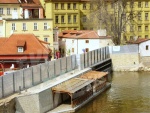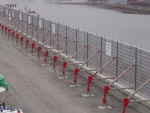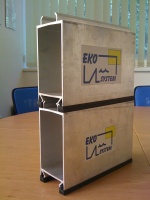Flood Walls and Mobile Barriers
 How does the EKO-SYSTEM flood walls technology work? It is a mobile wall that creates a vertical wall of any length that is able to retain the flood wave. It consists of two main parts: permanently built solid foundations and mobile barriers.
How does the EKO-SYSTEM flood walls technology work? It is a mobile wall that creates a vertical wall of any length that is able to retain the flood wave. It consists of two main parts: permanently built solid foundations and mobile barriers.Everything is based on an underground wall protecting an area against groundwater that rises simultaneously with the level of water flow. Its depth is based on bedrock and subsequent expected height of the barrier. The permanently mounted parts of a mobile barrier are attached to underground wall fittings. These are lateral guides, anchor plates and variantly low gate seats. Lateral guides are used to attach a mobile barrier to permanent structures and walls. Anchor plates are used to attach mobile poles, namely portable shores. There may be steel or stone sills or smooth even seating surface between anchor plates on which vertical stop logs are then stacked. All permanently mounted parts are made from high quality stainless steel. Mobile barriers are often placed on a solid wall that creates natural flood protection.
Flood Walls Construction
 Mobile barrier parts include portable shores, stop logs and tightening devices. Portable shores are steel welded H-shaped poles into which stop logs are inserted. They have profile sealing in the vertical direction. The surface is protected by hot-dip galvanizing. They are attached to solid anchor plates by means of screws. They are made for three types of stop logs: the width of 50, 90 and 100 mm. The height of protection is always a multiple of the height of the selected stop log type. The highest portable shores we have constructed so far are 6.270 mm high. Portable shores up to a height of 2.600 mm are constructed without lateral support. Higher portable shores are provided with support.
Mobile barrier parts include portable shores, stop logs and tightening devices. Portable shores are steel welded H-shaped poles into which stop logs are inserted. They have profile sealing in the vertical direction. The surface is protected by hot-dip galvanizing. They are attached to solid anchor plates by means of screws. They are made for three types of stop logs: the width of 50, 90 and 100 mm. The height of protection is always a multiple of the height of the selected stop log type. The highest portable shores we have constructed so far are 6.270 mm high. Portable shores up to a height of 2.600 mm are constructed without lateral support. Higher portable shores are provided with support. Stop logs are hollow and made from AlMgSi0.7 aluminum alloy. They are extrusions with the dimensions of 50/215, 90/165, 100/200 and 150/200 mm. They contain EPDM profile sealing in the lower part. They are used in various lengths, mostly up to 3.600 mm. Longer stop logs are not used due to storage and handling. The selection of individual types depends on stop logs spacing and barrier height.
Stop logs are hollow and made from AlMgSi0.7 aluminum alloy. They are extrusions with the dimensions of 50/215, 90/165, 100/200 and 150/200 mm. They contain EPDM profile sealing in the lower part. They are used in various lengths, mostly up to 3.600 mm. Longer stop logs are not used due to storage and handling. The selection of individual types depends on stop logs spacing and barrier height.To perfectly seal stop logs to each other, tightening devices are mounted to portable shores and lateral guides to tighten the individual stop logs. If barriers do not contain any bottom sealing threshold, the lower stop log is equipped with an additional microcellular threshold sealing that is able to balance bigger irregularities up to 15 mm.
In addition to maximum tightness and reliability, barriers of this type also bring many other advantages. In places, where the barriers are installed, the permanently mounted parts are almost invisible. They are built into the terrain in such a way that people will not notice them. Flood walls installation is fast and easy and it can even be done by untrained people. Mobile barrier parts do not require any mechanization. The stop logs of the same length are mutually interchangeable and cannot be misplaced during installation. Solid parts do not require any maintenance due to premium materials used. The mobile parts of flood walls can be easily stored. Stop logs are stored in bundles and portable shores in storage pallets. They can be loaded onto vehicles using fork-lifts to ensure faster installation. During storage no maintenance is necessary, visual check is sufficient.
The individual parts are described here.

 Angličtina
Angličtina Čestina
Čestina Němčina
Němčina